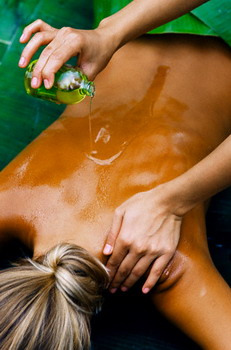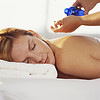Massage Oils, Lotions And Potions

Most massage treatments require the use of a lubricant in order to allow your hands to work smoothly and evenly over the skin without breaking the rhythm. This usually takes the form of oil, although lotions, creams and sometimes talcum powder can be used if you prefer. In general approximately 50ml is needed for a whole body massage. It may take a few tries to get it right; most people tend to use too much at first, which means you will not be able to make good contact. Your aim is to use just a thin layer that will be absorbed into the skin after the treatment.
Household Oils:
You can use oils that you keep at home in the kitchen cupboard – sunflower, grapeseed and vegetable oils make excellent carrier or “base” oils, as they are known professionally. If you want to pamper your partner, almond oil is a little costly but a real treat, particularly when used on the face. There is no need for you to worry about nut allergies because you are only applying oil externally and the penetration is superficial. However, some baby oils that include lanolin may cause an adverse skin reaction and tend to be absorbed less easily.

Essential Oils:
Those oils are very concentrated and powerful; many have contradictions, and unless you are a trained aromatherapist stick to the “safe oils”, such as lavender and chamomile, especially for pregnant women. Never apply essential oils neat to the skin, but always mix with a carrier oil in the ratio of 1 drop essential oil to 2 ml (scant 1/2 tsp) carrier oil. For example, 10 ml (2 tsp) sunflower oil would allow you to use a maximum of 5 drops of essential oil. Mix only enough for the treatment, as oils exposed to the atmosphere oxidize and become rancid.
Store aromatherapy oils in dark bottles so as not to destroy their properties. Always read the instruction leaflet carefully, and if in doubt consult a trained aromatherapist or use plain oil. There are now so many pre-blended oils available, covering all types of occasions and moods, that purchasing one of these is often the safest and most economical way of enhancing your massage treatment.
Lotions, Creams And Powders:

It is advisable not to receive massage if you have recently eaten a heavy meal or have drinking quantities of alcohol, as they will make the experience very uncomfortable and may produce unpleasant after-effects. The general rule is to trust your own judgement and common sense and, if in any doubt, check with a doctor.
Preparation:
Prepare oils in advance so that you do not interrupt the mood you are trying to create for the massage. The easiest and least messy method of dispensing oil is to keep it in a small flip-top plastic bottle, which will reduce the likelihood of spillage. Alternatively, pour some oil into a small bowl into which you can dip your fingers easily. Most lotions, creams and powders are ready-packaged in suitable containers. Always warm the oil and your hands before making contact. If possible, place the oil container in hot water or close to a heater for a few minutes before starting the massage.
Application And Contact:

The confidence with which you make contact with your partner’s skin and apply oil during massage is very important. The aim is for that first touch to feel relaxed and reassuring, transmitting the message that this is the start of the treatment and enabling your partner to get used to your touch. Most professional training teaches that you should not break contact with your partner during a massage, so one hand is placed on them throughout. At home, this may prove difficult at first, especially if you are massaging on the floor. Simply make sure that if you need to break and re-establish contact you do so in a smooth, gentle manner, maintaining the flow of the massage and not leaving your partner wondering whether the treatment is finished. A good massage should have a definite beginning and end so that it feels complete – do not leave your partner with a sense that something was missing.
Applying Oil:

1.There are various ways of applying oil. The most obvious is to pour about 2.5ml (1/2 tsp) of oil into the palm of one hand and then rub both palms together to spread the oil evenly. Do not be tempted to wring your hands as you might when washing or applying hand cream, because you want to oil the flat of your hands only. Make sure you apply the oil to your hands slightly away from your partner’s body and then gently bring your hands down on to your partner, ready to begin with a long application stroke.
2.The least intrusive way of applying more oil is to leave one hand on your partner’s body, slowly pour the oil over the back of the hand and then glide the flat of your hand across, spreading the oil on the body. A similar method is to turn your contact hand upward and cup it, then pour oil into the palm – this has the added benefit of re-oiling both hands when you glide the other hand over.